Epoxy Asphalt Test Data and Performance Details
What is Epoxy Asphalt?
The two-component Epoxy Asphalt binder, when cured, becomes a two-phase epoxy polymer that contains an asphalt extender. The continuous phase is an acid cured epoxy and the discontinuous phase is a mixture of asphaltic materials. It is a thermoset polymer (it will not melt). This binder, combined with high quality standard asphalt paving aggregates in a dense graded paving mix, forms an impermeable tough polymer concrete called Epoxy Asphalt Concrete. A hot spray application of an Epoxy Asphalt bond (tack) coat precedes the laying of the Epoxy Asphalt Concrete to provide a very high strength bond to the substrate (concrete, steel or asphalt) that won’t melt.
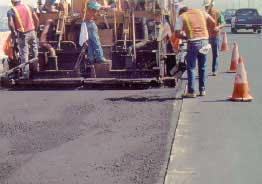
Advantages
Fatigue Resistance
The excellent fatigue resistance of Epoxy Asphalt enables it to maintain its integrity on orthotropic steel bridge decks without cracking even after the deflections caused by millions of wheel loads. The fatigue resistance is 3-4 orders of magnitude (of fatigue load cycles) higher than polymer modified asphalt binders. The composite action of the epoxy asphalt, unlike that of more flexible pavements, increases the fatigue life of the steel deck and structure by reducing deflection, and thus strain, in the steel.
Corrosion Protection
Epoxy Asphalt provides another layer of corrosion protection for the steel deck in addition to the primary corrosion protection coating because of its low void content of less than 3%. The voids that exist are not interconnected. The result is an impervious (non-porous) pavement with extreme resistance to penetration of water and chloride ions. The non-permeable properties of Epoxy Asphalt pavement have been verified by third party labs using AASHTO Test Method T259 (Resistance of Concrete to Chloride Ion Penetration).
Resistance to Rutting and Shoving
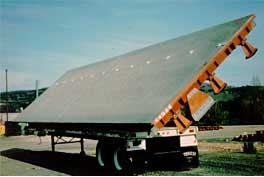
Because Epoxy Asphalt binder is a thermoset polymer (as opposed to a thermoplastic polymer such as conventional and rubber-modified asphalt), it provides excellent resistance to rutting and shoving even under high wheel loads in hot and cold climates. The new generation Type IX Epoxy Asphalt has exhibited world record Marshall strengths of >100 kN for a flexible pavement in several recent applications.
Skid Resistance
Epoxy Asphalt pavements include high quality, polish resistant aggregates that provide outstanding skid resistance throughout their life. The Epoxy Asphalt binder does not “bleed” as do thermoplastic bituminous paving materials when the pavement gets hot. As soon as the binder on the aggregate exposed to traffic wears off, vehicle tires see only the aggregate.
Oxidation Resistance
Epoxy Asphalt binders exhibit extremely low rates of oxidation and loss of resiliency unlike standard and polymer modifed binders. Pavements and overlays constructed with Epoxy Asphalt maintain their properties and do not become more rigid (more brittle) with time. These properties have been validated by several OECD research studies seeking a long-lived pavement for busy roads conducted by the International Transport Forum. In addition, New Zealand is using Epoxy Asphalt on their urban motorways as a extended life binder for open-graded porous pavements (with ~20% voids), in an application where the binder is exposed to more air and water by design due to the intentional higher permeability of the pavement.
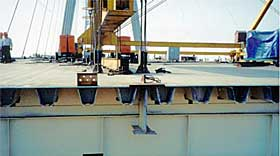
Delamination Resistance
Epoxy Asphalt pavements include a separate, high strength, temperature resistant (non-melting) bond coat. Unlike regular or polymer modified asphalts, the Epoxy Asphalt bond coat provides a high strength bond to the underlying substrate (concrete or steel) even at elevated temperatures of 158°F (70°C) which can occur on a hot summer day. In some cases, where delamination has been identified previously as a primary cause of failure, the Epoxy Asphalt bond coat has been successfully employed with polymer modified SMA pavements on steel decks.
Minimum Traffic Delays
Epoxy Asphalt provides the absolute minimum delays for re-paving (and sometimes re-decking) existing bridges under traffic. An Epoxy Asphalt pavement is ready for traffic in its partially cured state once it has cooled to ambient temperature. The one-day-old uncured Marshall stability of type IX Epoxy Asphalt (measured at 60°C) is generally > 2000 lb (9.4 kN). It develops full strength over two to four weeks depending on average daily temperatures.
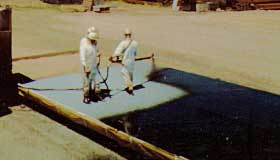
Local Paving Crews
Local paving crews using conventional asphalt paving equipment install Epoxy Asphalt. ChemCo Systems technical staff provide training and technical support during the project. ChemCo supplies the special blending equipment (meter-mix machine) for the two Epoxy Asphalt components. This special equipment is operated by local labor. There is no need to import specialized labor.
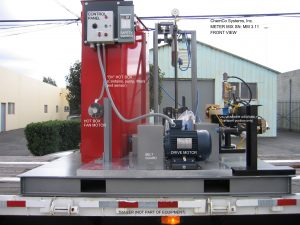
Applications
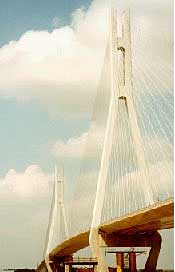
Epoxy Asphalt placements on orthotropic steel decks range from the San Mateo-Hayward bridge, paved in 1967, to the SuTong Bridge, which was completed in 2007 and many others [see last table]. The San Mateo-Hayward pavement lasted over 49 years with no maintenance. Orthotropic decks using epoxy asphalt include bridges paved in Canada, Australia, Brazil, China, South Korea, Thailand and Viet Nam. Several bridges have been paved with Epoxy Asphalt and then, after 25-35 years of successful service, re-paved with the next generation version of Epoxy Asphalt. Epoxy Asphalt has been successfully used in climates with winter temperatures below 0°F (-18°C) and summer deck temperatures reaching 170°F (77°C).
Installation
The concrete deck of the heavily traveled Golden Gate Bridge was replaced and paved with no daytime lane closures. Lane shutdown began at 8 PM, paving began at 10 PM and all lanes were opened at 5 AM the next morning. Throughout the night at least one lane was always open in each direction for traffic. Epoxy Asphalt technology helps meet the challenge of replacing old concrete bridge decks with orthotropic steel decks while minimizing traffic interruption. Shop applied Epoxy Asphalt Chip Seal provides a durable skid resistant surfacing that protects each steel plate from wear and corrosion until all plates are in place and welded together. This technique was recently employed on the Macdonald Bridge in Halifax, Nova Scotia during a deck replacement project and the bridge remained open to traffic during daytime commute hours. Epoxy Asphalt concrete provides the long term wearing surface when it is installed after all deck plates are in place. Both the Golden Gate Bridge and the Lions Gate Bridge used this system for their deck replacement projects. The Macdonald Bridge also used Epoxy Asphalt chip seal on the replacement deck sections and a smaller tan-colored aggregate gradation in the Epoxy Asphalt tack coat surfacing for its sidewalks and bikeways as shown on the sides of the 3 lane roadway in the image above.
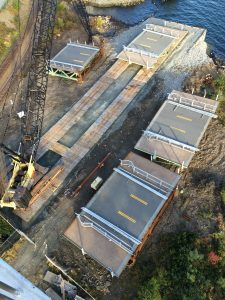
Epoxy Asphalt Concrete vs. Asphalt Concrete
| Property | Test Method (ASTM) | Asphalt Concrete | Epoxy Asphalt |
|---|---|---|---|
| Marshall Stability @ 140°F, lb. | D1559 | 2,500 | 22,000 |
| Marshall Stability @ 400°F, lb. | D1559 | melts | 8000 |
| Flow value @ 140°F, in. | D1559 | 0.11 | 0.08 |
| Recovery % min. | D1559 | 0 | 60 |
| Compressive strength @ 77°F, psi | D695 | 167,000 | |
| Flex. modulus of rupture @ 77°, psi | D293 | 81 | 640 |
| Flex. modulus of elasticity @ 77°, psi | D293 | 380,000 | |
| Max. deflection, inch | D293 | 0.1 | 0.15 |
| Air voids, % | D2041 | 3 to 5 | 1 to 2 |
Epoxy Asphalt Binder & Bond Coat (Neat)
| Property | Test Method (ACI) | Value | Failure Location |
|---|---|---|---|
| Tensile Bond Strength to Inorganic Zinc Coated Steel, psi, (mPa) | ACI 503R | 500, (3.4) | Bond Coat |
| Tensile Bond Strength to Portland Cement Concrete, psi | ACI 503R | 350 | Portland Cement Concrete |
Fatigue Resistance
Properly designed Epoxy Asphalt Pavements for orthotropic steel bridge decks provide a durable surface that resists fatigue cracking in the pavement in the negative moment area above the longitudinal stiffeners. Additionally, the pavement, acting as one element in the composite deck system, reduces deck deflection under load and thus increases the fatigue life of the steel deck plate itself.
On many projects, ChemCo Systems labs can provide accelerated cyclic fatigue testing by making composite specimens to match the design of a specific deck. The composite specimen uses the same pavement thickness and number of lifts as called for and then loads the specimen at 10 hertz cycles to simulate the highest axle loads (including an overweight factor) expected.
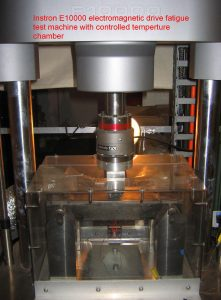
Deck Deflection Comparison1
| Load, kN | ||||||||
|---|---|---|---|---|---|---|---|---|
| Load, kN | 1.0 | 2.0 | 3.0 | 4.0 | 5.0 | 6.0 | 7.0 | 8.0 |
| Deflection, Bare Steel Plate, mm | 0.06 | 0.16 | 0.26 | 0.36 | 0.46 | 0.57 | 0.67 | 0.78 |
| Deflection, Epoxy Asphalt/Steel Composite, mm | 0.03 | 0.12 | 0.18 | 0.26 | 0.34 | 0.42 | 0.51 | 0.60 |
Dynamic testing conducted in independent civil engineering laboratories have shown that Epoxy Asphalt pavements resist fatigue cracking over a wide range of conditions. The following table summarizes recent results.
Fatigue Test Results of Epoxy Asphalt — Steel Deck Composite 1,2
| Temperature, °C | Static Deflection, mm | Dynamic Deflection, mm | Cycles to Failure |
|---|---|---|---|
| 0 | 0.25 | 0.02 | 12x106 with no failure |
| 18 | 0.35 | 0.18 | 12x106 with no failure |
| 60 | 0.61 | 0.58 | 12x106 with no failure |
Above Test Results from Southeast University, Nanjing, China, 2000
- Test specimen: 14 mm plate 100 mm wide, center point load from underside.
- Test load: 5kN load @ 10 Hz frequency
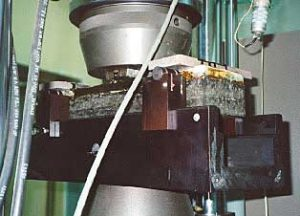
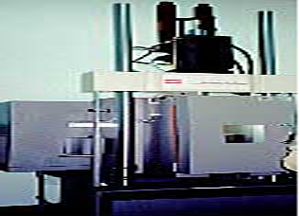
History of Epoxy Asphalt Pavements: Over 65 Bridges and 450 Km of Bridge Lanes Paved
| Name of bridge | Location | Date | Deck Type | Area sq.feet | Area sq.meter | Approx.Tons |
|---|---|---|---|---|---|---|
| San Mateo-Hayward | San Mateo, CA | 1967 | 9/16" O-T Steel | 430,000 | 39,948 | 5,495 |
| San Diego-Coronado | San Diego, CA | 1969 | 3/8" O-T Steel | 116,000 | 10,777 | 1,482 |
| San Francisco- Oakland Bay Bridge | San Francisco, CA | 1969 | PC Concrete | 155,000 | 14,400 | 1,981 |
| McKay | Halifax, N. S. | 1970 | 3/8" O-T Steel | 128,000 | 11,892 | 1,636 |
| Queensway A | Long Beach, CA | 1970 | O-T Steel | 96,000 | 8,919 | 1,227 |
| MacDonald | Halifax, N. S. | 1971 | Conc. Filled StI. Grid Main Span | 119,000 | 11,055 | 1,521 |
| Ross Island | Portland, OR | 1972 | PC Concrete | 146,000 | 13,564 | 1,866 |
| Evergreen Point | Seattle, WA | 1972 | PC Concrete | 270,000 | 25,084 | 3,450 |
| Sellwood | Portland, OR | 1973 | PC Concrete | 47,000 | 4,366 | 601 |
| Fremont | Portland, OR | 1973 | 5/8" O-T Steel | 155,000 | 14,400 | 1,981 |
| Costa de Silva (Rio-Niteroi) | Rio de Janeiro, Brazil | 1973 | 3/8" O-T Steel | 220,000 | 20,439 | 2,811 |
| 1-94 Bridges | Minneapolis, MN | 1973 | PC Concrete | 99,000 | 9,197 | 1,265 |
| Mercer | Montreal, Quebec | 1974 | 3/8" O-T Steel | 21,000 | 1,951 | 268 |
| Lions Gate | Vancouver, B. C. | 1975 | 15/32" O-T Steel | 77,000 | 7,154 | 984 |
| San Francisco-Oakland Bay Bridge | San Francisco, CA (lower deck of 2) | 1976 | PC Concrete | 1,475,000 | 137,032 | 137,032 |
| SF Bay Br. | 2nd deck (upper) | 1977 | lightwt concrete | 1,290,000 | 119,845 | 116,485 |
| Luling | New Orleans, LA | 1983 | 7/16" O-T Steel | 219,000 | 219,000 | 2,799 |
| Ben Franklin (deck replacement | Philadelphia, PA | 1986 | 5/8" O-T Steel | 632,000 | 58,715 | 8,076 |
| Golden Gate (deck replacement) | San Francisco, CA | 1986 | 5/8" O-T Steel | 576,000 | 53,512 | 7,361 |
| McKay | Halifax, N. S. | 1990 | 3/8" O-T Steel | 128,000 | 11,892 | 1,636 |
| San Diego-Coronado | San Diego, CA | 1993 | 3/8" O-T Steel | 1,650 | 153 | 21 |
| Champlain | Montreal, Quebec | 1993 | 3/8" O-T Steel | 200,000 | 18,581 | 2,556 |
| Maritime Off-Ramp | Oakland, CA | 1996 | 5/8" O-T Steel | 69,075 | 6,417 | 883 |
| 2nd Yangtze Bridge | Nanjing, China | 2000 | 14 mm(approx. 9/16") O-T Steel | 548,527 | 50,960 | 7,014 |
| Lions Gate Bridge (deck replacement) | Vancouver, B.C. | 2002 | O-T Steel | 77,000 | 7,154 | 700 |
| Taoyaomen | Zhoushan, China | 2003 | 14 mm O-T Steel | 278,173 | 25,843 | 3,557 |
| Runyang Cable-stay | Zhenjiang, China | 2004 | 14 mm O-T Steel | 308,348 | 28,646 | 3,943 |
| Runyang Suspension | Zhenjiang, China | 2004 | 14 mm O-T Steel | 572,646 | 53,201 | 7,323 |
| Dagu | Tianjin,China | 2004 | O-T Steel | 66,640 | 6,191 | 833 |
| 3rd Yangtze Bridge | Nanjing, China | 2005 | O-T Steel | 525,066 | 48,780 | 6,714 |
| Pingsheng | Nanjing, China | 2006 | 14 mm O-T Steel | 525,066 | 48,780 | 6,714 |
| Zhanjiang Bay | Zhanjiang, China | 2006 | O-T Steel | 169,474 | 15,745 | 2,167 |
| Fenghua | Tianjin, China | 2006 | O-T Steel | 13,132 | 1,220 | 168 |
| Nanhuan | Beijing, China | 2006 | O-T Steel | 115,626 | 10,742 | 1,479 |
| Sutong | Nantong, China | 2007 | O-T Steel | 764,000 | 70,978 | 10,943 |
| Hangzhou Bay (2 bridges) | Ningbo, China | 2007 | O-T Steel | 737,327 | 68,500 | 9,429 |
| Yangluo | Wuhan, China | 2007 | O-T Steel | 521,715 | 48,469 | 6,671 |
| Houhai | Shenzhen, China | 2007 | O-T Steel | 44,910 | 4,172 | 574 |
| Fu Ming, Chin Feng, Li Gong, Si Hai | Tianjin China | 2007 | O-T Steel | 138,439 | 12,861 | 1,770 |
| Huang Pu (2 bridges) | Guangzhou China | 2008 | O-T Steel | 556,830 | 51,731 | 8,700 |
| Xihoumen and Jintang | Zhoushan China | 2008 | O-T Steel | 800,868 | 74,403 | 10,110 |
| 3rd Yellow River | Jintan China | 2008 | O-T Steel | 333,976 | 31,027 | 4,271 |
| YuZui | Chongqing China | 2009 | O-T Steel | 200,800 | 18,655 | 3,100 |
| BaLing | Guizhou China | 2009 | O-T Steel | 261,888 | 24,330 | 4,043 |
| Baishazhou | Wuhan China | 2009 | O-T Steel | 378,888 | 35,200 | 8,786 |
| Xiangluowan | Tianjin China | 2009 | O-T Steel | 31,609 | 2,937 | 486 |
| Thuon Phuoc | DaNang Viet Nam | 2009 | O-T Steel | 84,368 | 7,838 | 1,079 |
| Banpald | Bangkok Thailand | 2009 | O-T Steel | 40,922 | 3,802 | 523 |
| Pong Pech | Bangkok Thailand | 2009 | O-T Steel | 40,922 | 3,802 | 523 |
| Rama IV | Bangkok Thailand | 2009 | concrete | 54,562 | 5,069 | 698 |
| E'dong Bridge | Hu Bei, China | 2010 | O-T Steel | 258,287 | 23,996 | 3,311 |
| Jing yue Bridge | Hu Bei, China | 2010 | O-T Steel | 403,544 | 37,491 | 6,243 |
| Qing dao Bay Bridge (2 bridge spans) | Qing Dao, China | 2010 | O-T Steel | 517,160 | 48,046 | 8,000 |
| Chong Qi Bridge | Jiang Su, China | 2011 | O-T Steel | 265,296 | 265,296 | 4,100 |
| South Train Station Bridge | Nan Jing, China | 2012 | O-T Steel | 275,551 | 25,600 | 4,257 |
| Fremont Bridge | Portland, OR | 2012 | 5/8" O-T Steel | 176,287 | 16,378 | 2,253 |
| Jiu jiang Second Bridge | Jiang Xi, China | 2013 | O-T Steel | 358,457 | 33,302 | 5,543 |
| Huang yi Bridge | Si Chuan, China | 2013 | O-T Steel | 100,097 | 9,299 | 1,543 |
| Tao hua yu Bridge | Zheng Zhou, China | 2013 | O-T Steel | 237,604 | 22,074 | 3,671 |
| San Francisco-Oakland Bay Bridge | San Francisco, CA | 2013 | O-T Steel | 358,953 | 33,348 | 3,900 |
| Ulsan Grand Harbor | Ulsan, Korea | 2014 | O-T Steel | 247000 | 23000 | 2875 |
| Dandeung | Gunsan, Korea | 2015 | O-T Steel | 86000 | 8000 | 1000 |
| Jishan-Haihe | Tianjin, China | 2016 | O-T Steel | 140000 | 13000 | 1841 |
| Xinshiji | Tonglio, China | 2016 | O-T Steel | 84000 | 7800 | 1105 |
| Macdonald (in-service deck replacement) | Halifax, Canada | 2016-18 | O-T Steel | 89000 | 8261 | 725 |
| New Millennium(Saecheonnyeon) | Shinan, Korea | 2018 | O-T Steel | 207130 | 19250 | 2478 |
| Tianxingzhou | Wuhan, China | 2019 | O-T Steel | 206000 | 19150 | 2700 |
Tell us about your project
CALL 650-261-3790.

